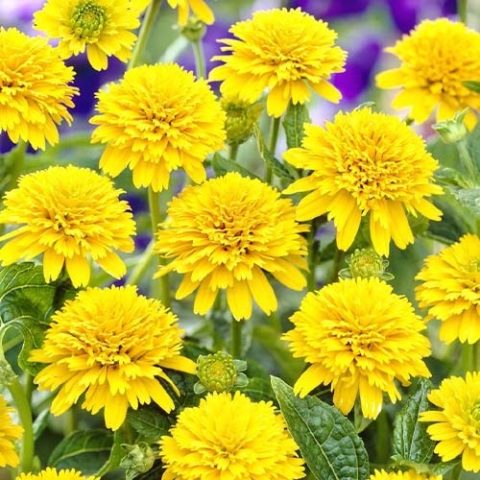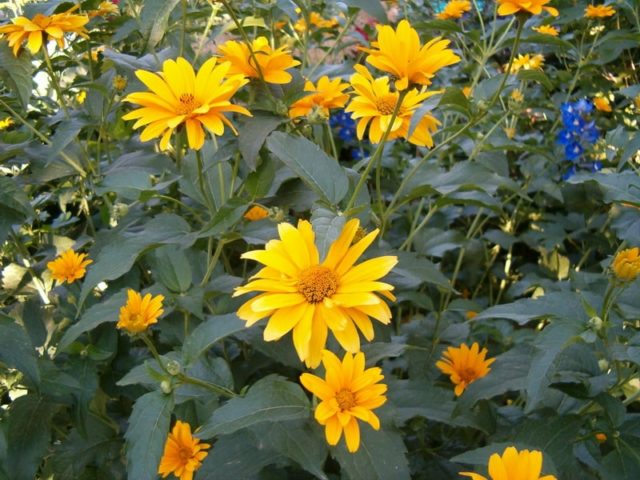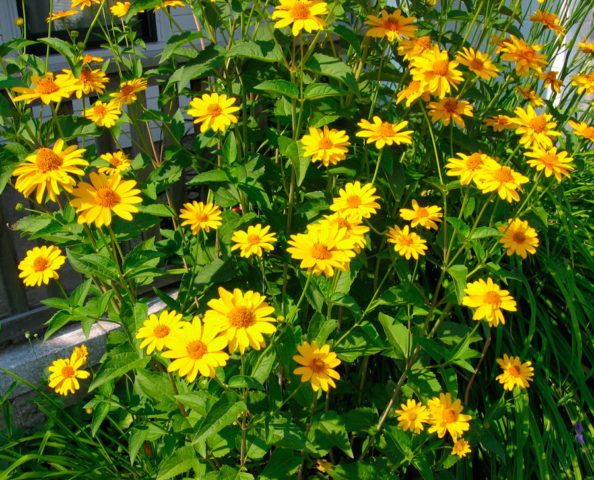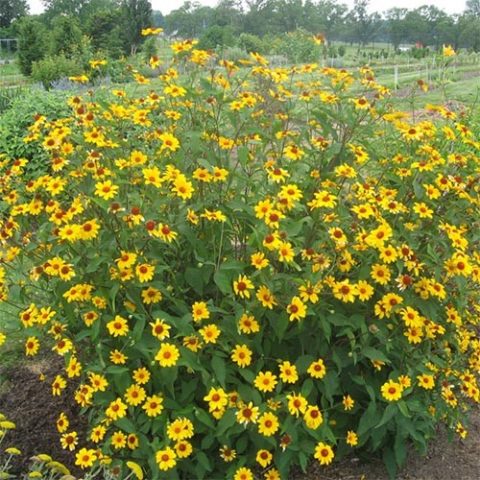Content
Variegated Heliopsis is a common perennial plant that is grown for ornamental purposes. This flower has gained great popularity among gardeners due to its unpretentious care, resistance to frost, drought. Variegated heliopsis can grow in almost any conditions. At the same time, it blooms regularly and for a long time, decorating the site.
Description of variegated heliopsis
Herbaceous plant from the Asteraceae family. The average height is 80-90 cm. Some specimens reach 160 cm. The plant is erect, with numerous shoots.
The difference between variegated heliopsis from other species lies in the color and arrangement of the leaves. In most representatives of this genus, they are dark green, opposite or alternate. In variegated heliopsis, they are light in color, some varieties with small villi, due to which a silvery sheen appears.
The flowers of the plant are often yellow. Rarely are varieties with orange, red, purple or lilac buds. Heliopsis, belonging to the variegated group, bloom in late June or July.
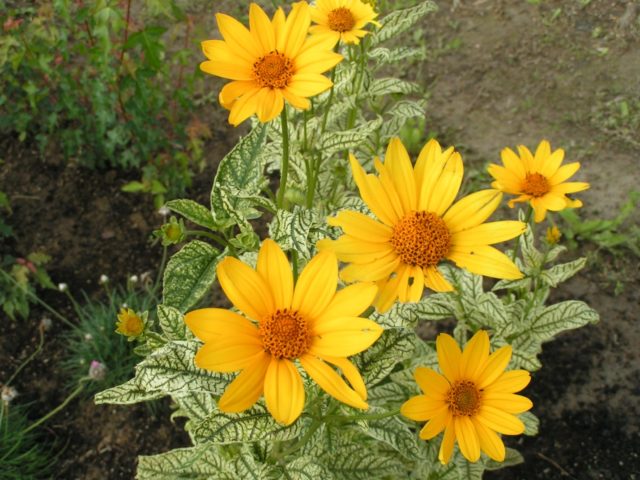
Flowering continues throughout the summer
The shape and size of the buds varies depending on the variety of variegated heliopsis. There are double and simple baskets, as well as complex paniculate inflorescences.
Types and varieties
When choosing a variegated heliopsis for planting on a site, several important features of the plant must be taken into account. Varietal affiliation is of primary importance. There are many types.
Heliopsis variegated
Herbaceous plant, up to 90 cm high. It has several erect stems with dense feathery foliage. The inflorescences are simple, in the form of baskets. Their diameter reaches 10 cm.
Flowering lasts from early summer to autumn. The color of the petals is bright yellow. The central part of the flower is orange.
The decorative value lies in the unique color of the foliage. In the photo of variegated heliopsis, dark green veins on light plates are noticeable.

The flower is planted in partial shade to make the leaves look more contrasting.
The most prominent representative of variegated heliopsis is the Lorain Sinshine variety. It has beautiful foliage that retains its decorative effect until late autumn.
Terry
Some types of variegated heliopsis have complex inflorescences, consisting of a large number of petals. Terry varieties are typical of Summer Night and Goldenfieder.
These are plants with high erect stems, dense foliage, numerous rounded flowers.
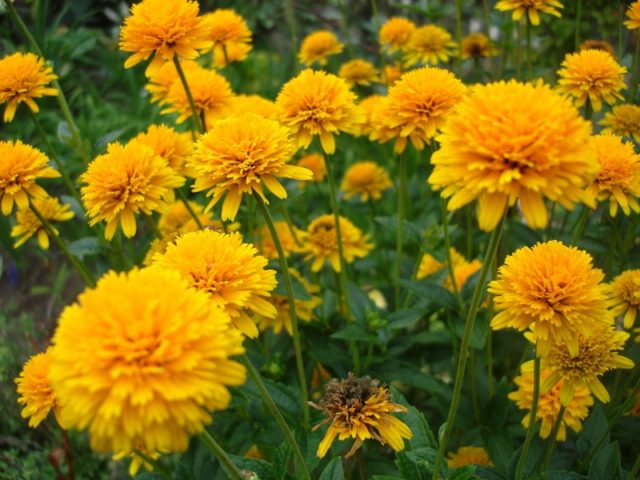
Terry heliopsis height - up to 120 cm
The flower grows well in sunlit areas. Landing in partial shade is allowed.
The plant is resistant to adverse factors. It is practically insensitive to disease and rarely attracts pests.
Sunflower
Erect branched semi-shrub, up to 1 m high.Consists of a large number of stems, abundantly covered with large oval leaves with jagged edges. Inflorescences-baskets up to 9 cm in diameter.

Some varieties bloom twice a season.
Blooming of sunflower heliopsis continues all summer. Under favorable conditions, the plant begins to wilt only in October.
Rough
It is considered the most numerous species. Includes many varieties with double and semi-double flowers.
Among the most popular:
- Summer Sun
- Sunburst;
- Golden Plume;
- Burning Hearts
- Sonnen Child.
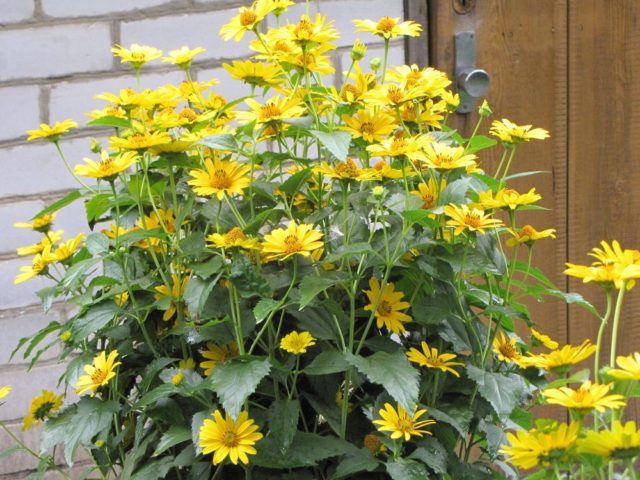
Rough heliopsis does not require a garter and additional support
The plant blooms in mid-summer. In the south and in the regions of the middle lane, flowering continues until the first frost.
Other varieties
Variegated heliopsis are subdivided according to the height of the plant. In landscape design, medium-sized varieties are usually used.
These include:
- Ballerina (Ballerina);
- Asahi;
- Tuscan Sun;
- Summer Green.
Such specimens grow up to 70 cm. Some gardeners prefer to grow tall variegated heliopsis.
Among them:
- Golden Plum;
- Midwest Dream (Midwest Dream);
- Venus (Venus);
- Summer Knight (Summer Night).
Low-growing varieties of heliopsis are used as ground cover plants. Many of them are not designed for planting in open ground.
Application in landscape design
Variegated heliopsis is used for single and group planting. The flower is unpretentious, so different varieties can be combined and planted in the immediate vicinity.
Variegated heliopsis goes well with other ornamental plants:
- asters;
- chrysanthemums;
- gladioli;
- delphiniums;
- phlox;
- hydrangeas.
Often heliopsis is used to create a flower arrangement in yellow-orange tones. For a monochrome garden, they are combined with other plants with a similar color.
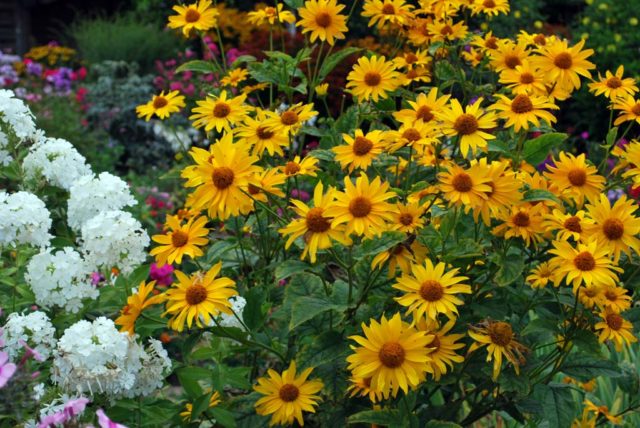
Photophilous cultures are planted next to variegated heliopsis
Variegated heliopsis are suitable for planting in rockeries, rock gardens. They are often included in mixborders, giving them a central position in the flower garden.
Reproduction of variegated heliopsis
You can get a new plant by dividing the bush. Also allows the possibility of growing from seeds.
By dividing the bush
The procedure is carried out in spring or autumn. The mother bush should be healthy, 4-5 years old.
Division stages:
- Dig in the plant and remove it from the soil.
- Clean the roots from hard clods of soil.
- Separate several shoots with roots from the bush.
- Return the mother plant to the soil.
Delenki are disinfected and soaked in a growth stimulator. After that, they are planted in open ground or in a container.
Growing seedlings from seeds
Sowing is carried out in winter, in February. Stratification is required first. For planting, use seedling cassettes, pots or containers.
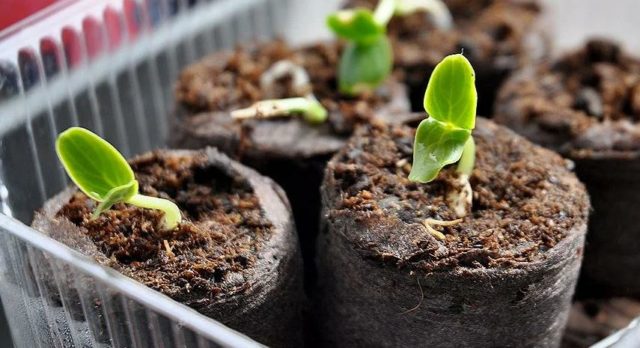
You can grow seedlings of heliopsis in peat tablets
Seeds are sown at a distance of 4-5 cm. They are lightly sprinkled with loose soil, sprayed. The container is covered with a film, which is periodically removed. Sprouts break through after 2-3 weeks. When 3 leaves appear, a pick is carried out.
The seedlings are kept on the windowsill so that they receive light. A month before landing in the ground, they begin to harden it, taking it out into the open air.
Planting and caring for variegated heliopsis
In order for the plant to develop normally and bloom annually, it is necessary to observe the cultivation technology. The planting procedure requires special attention.
Timing
Seedlings grown in late winter are planted in early to mid-May. The air temperature at night should not be lower than 8 degrees.Planting in early June is acceptable, but then there is a risk that variegated heliopsis will not bloom in the first year.
Site selection
The bush is planted in an area with loose nutrient soil. The place should be well lit by the sun, protected from the wind. Standard potting mix for ornamental plants is recommended.
It consists of:
- leafy land;
- turf;
- peat;
- river sand;
- compost.
The mixture is made 2-3 weeks before planting. If possible, it should be sterilized by heat treatment.
Landing algorithm
The place needs to be cleared of weeds, remove other plant debris. Planting is best done in the evening.
How to plant heliopsis:
- Dig a planting hole 35-40 cm deep.
- Place a drainage layer of expanded clay or pebbles on the bottom.
- Sprinkle with soil.
- Remove the seedling from the seedling container.
- Place it in the pit.
- Cover with soil and water.
After disembarkation, variegated heliopsis requires liquid. It should be watered every 3-4 days.
When and how to replant
Bushes of variegated heliopsis grow in one place for up to 20 years. A transplant is not always required. It is carried out only if the bush grows strongly and takes up a lot of space. At the same time, root division is performed.
Watering and feeding schedule
Heliopsis is drought tolerant. In the summer it is enough to water once a week. In case of heavy rainfall, the frequency can be reduced. In autumn, water is given once every 12-14 days. The liquid is poured under the root, trying not to get on the leaves.

Each bush requires 10-15 liters of water
Top dressing is introduced from the second year. It is enough to apply fertilizers once a month. Use complex mineral formulations for flowering plants. Organic variegated heliopsis can be fertilized in spring.
Loosening and weeding
The stagnation of liquid in the soil is destructive and can provoke rotting of the roots. As the soil is compacted, it must be loosened to a depth of 10-12 cm. The procedure is carried out with care so as not to touch the surface roots.
Weeds growing near heliopsis need to be removed periodically. The most dangerous are liana-like plants that can twine around the stems.
Other activities
Variegated varieties of heliopsis lend themselves well to pruning. For preventive purposes, it is carried out in spring and autumn. Peduncles, dried shoots, leaves are removed from the plant.
To form a bush and abundant flowering, you can pinch. During the procedure, the top of the young stems are removed. This stimulates the growth of side shoots.
Wintering
The preparation involves full pruning. The stems are removed to ground level. To protect the roots lying close to the surface, they are covered with dry foliage or needles. Such procedures must be carried out before the onset of the first frost. It is not recommended to apply mineral fertilizers.
Diseases and pests
The technology of planting and caring for variegated heliopsis provides for additional measures aimed at preventing diseases. The plant is resistant to many infections. However, the risk of disease is not completely ruled out.
Possible diseases:
- rust;
- powdery mildew;
- gray rot;
- fusarium.
Treatment involves removing the affected shoots and spraying the bush with a Bordeaux mixture or a solution of copper sulfate. Processing is carried out 2-3 times with an interval of 2 days.
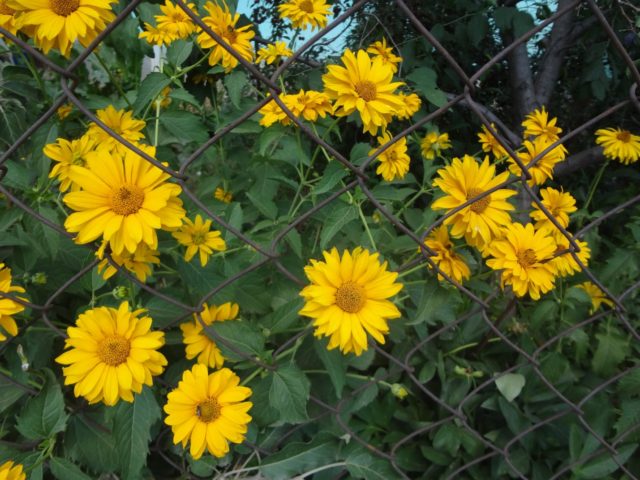
For prevention, bushes can be sprayed with fungicides.
Black aphid is widespread among the pests of heliopsis. You can get rid of it with insecticides or folk remedies. The most effective is the infusion of tomato with celandine or wormwood. They are sprayed with a flower, adding to soapy water.
Conclusion
Variegated Heliopsis is an ornamental perennial appreciated by gardeners for long bright flowering and ease of care. The plant does not require special conditions for growing, it feels good in the sun and in partial shade. Heliopsis is drought tolerant and, if properly prepared, tolerates winter normally.

